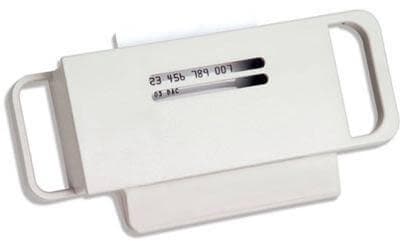
How to Use a Credit Card Imprinter
Safe to say, credit card imprinters might appear outdated. Nevertheless, they remain a dependable alternative payment method during power interruptions or system malfunctions.
In this article, we will discuss the step-by-step instructions on how to effectively use a credit card imprinter, explain its ongoing significance, and offer tips to ensure seamless transactions with each imprint.

What Is a Credit Card Imprinter?
A credit card imprinter, is a manual device used to capture credit card details by making an imprint of the raised numbers and letters on the card onto a carbon paper slip. This slip serves as a physical record of the transaction.
Though modern payment methods dominate today’s retail space, credit card imprinters remain a crucial backup system, especially in situations where electronic payment terminals are unavailable.
Why Use a Credit Card Imprinter?
While most businesses rely on electronic card readers, there are specific situations where a credit card imprinter is still necessary:
- Backup for Power Outages: When electronic card machines fail due to technical issues or power outages, an imprinter ensures you can still process payments.
- Mobile Transactions: Businesses that operate in remote areas without internet access can use an imprinter as a reliable alternative.
- Emergency Situations: A credit card imprinter allows businesses to continue accepting payments even when network connections are down.
How to Use a Credit Card Imprinter
Using a credit card imprinter is simple, but it requires a few steps to ensure accuracy and efficiency. Here’s a step-by-step guide:
1. Prepare the Imprinter
Before using the device, make sure you have the necessary supplies:
- A functioning credit card imprinter
- Carbon copy credit card slips
- A valid credit card
Place the imprinter on a flat, sturdy surface for a clean and clear imprint.
2. Insert the Credit Card Slip
Open the imprinter and insert the credit card slip into the designated slot. Ensure it is aligned properly so all transaction details are imprinted correctly.
3. Position the Credit Card
Place the customer’s credit card face-up on the imprinter. Align it with the designated area so the raised numbers and letters are directly below the carbon slip.
4. Make the Imprint
Close the imprinter and firmly slide the handle from one end to the other. Then, slide it back to its original position. This motion presses the credit card’s raised details onto the carbon slip, creating a readable imprint.
5. Check the Imprint
Carefully remove the slip and check that all necessary details—card number, expiration date, and cardholder name—are clearly imprinted. If the details are faint or missing, repeat the process with more pressure.
6. Complete the Transaction
Have the customer sign the slip. One copy goes to the customer, while the business retains the other copy for records.
7. Process the Payment Later
Once electronic systems are restored, manually enter the transaction details into your POS system or submit the slip to the bank for processing.
While digital payment methods dominate the market, having a credit card imprinter as a backup ensures your business can continue accepting payments in any situation.
